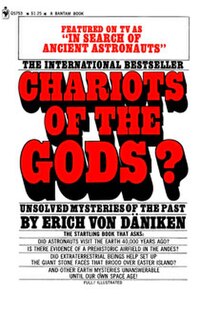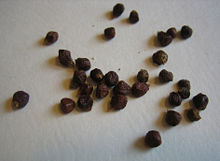Chariots of the Gods?
From Wikipedia, the free encyclopedia
For the 1970 documentary film, see Chariots of the Gods (film).
| Chariots of the Gods? Unsolved Mysteries of the Past | |
|---|---|
 | |
| Author(s) | Erich von Däniken |
| Original title | Erinnerungen an die Zukunft: Ungelöste Rätsel der Vergangenheit |
| Publisher | Econ-Verlag (Germany) Putnam (USA) |
| Publication date | 1968 |
Chariots of the Gods? Unsolved Mysteries of the Past (German: Erinnerungen an die Zukunft: Ungelöste Rätsel der Vergangenheit) is a book authored in 1968 by Erich von Däniken. It involves the hypothesis that the technologies and religions of many ancient civilizations were given to them by ancient astronauts who were welcomed as gods.
Prior to publication, the book was extensively rewritten by its editor, Wilhelm Roggersdorf (a pen name of the German screenwriter Wilhelm "Utz" Utermann).[1][2][3]
Contents[hide] |
[edit]Content
Von Däniken offers the following hypotheses:
- The existence of structures and artifacts have been found which represent higher technological knowledge than is presumed to have existed at the times they were manufactured. Von Däniken maintains that these artifacts were produced either by extraterrestrial visitors or by humans who learned the necessary knowledge from them. Such artifacts include the Egyptian pyramids, Stonehenge, and the Moai of Easter Island. Further examples include a medieval map known as the Piri Reis Map, allegedly showing the Earth as it is seen from space, and the Nazca lines in Peru, which he explains as landing strips for an airfield.
- Interpretations of ancient artwork throughout the world as depictions of astronauts, air and space vehicles, extraterrestrials, and complex technology. Däniken also describes elements that he believes are similar in art of unrelated cultures.
- Explanations for the origins of religions as reactions to contact with an alien race, including interpretations of the Old Testament of the Bible. According to von Däniken, humans considered the technology of the aliens to be supernatural and the aliens themselves to be gods. Däniken asks if the oral and literal traditions of most religions contain references to visitors from stars and vehicles travelling through air and space. These, he says, should be interpreted as literal descriptions which have changed during the passage of time and become more obscure. Examples such as:Ezekiel's revelation in Old Testament, which he interprets as a detailed description of a landing spacecraft with angels in the likeness of man. Moses and the directions 'God' gave him to construct the Ark of the Covenant, which is assumed to be a communication device with an alien race. Lot and his extended family being ordered by human like 'angels' to go to the mountains, due to the destruction of the city of Sodom by God. His wife looked back at the possiblenuclear explosion, and fell "dead on the spot". Däniken attempts to draw an analogy with the "cargo cults" that formed during and after World War II, when once-isolated tribes in the South Pacific mistook the advanced American and Japanese soldiers for gods.
[edit]Response
Scientists and historians have rejected his ideas, claiming that the book's conclusions were based on faulty, pseudoscientific evidence, some of which was later demonstrated to be fraudulent or fabricated, and under illogical premises. For example, Ronald Story wrote a book rebutting Däniken's ideas in 1976 titled The Space Gods Revealed. A similar internationally bestselling book, entitled Crash Go The Chariots by Clifford Wilson, appeared in 1972.
Soon after the publication of Chariots of the Gods? von Däniken was accused of stealing the ideas of French author Robert Charroux.[4]
A 2004 article in Skeptic magazine[5] states that von Däniken plagiarized many of the book's concepts from The Morning of the Magicians, that this book in turn was heavily influenced by the Cthulhu Mythos, and that the core of the ancient astronaut theory originates in H. P. Lovecraft's short stories "The Call of Cthulhu" and "At the Mountains of Madness".
One artifact offered as evidence in the book has been disclaimed by Däniken himself. Chariots asserts that a non-rusting iron pillar in India was evidence of extraterrestrial influence, but Däniken admitted in a Playboy interview (vol.21, no.8, August 1974) that the pillar was man-made and that as far as supporting his theories goes "we can forget about this iron thing." Neither this nor any other discredited evidence has been removed from subsequent editions ofChariots of the Gods.[6][7]
One book commonly cited in support of von Däniken is The Spaceships of Ezekiel by former NASA design engineer Josef F. Blumrich (March 17, 1913 – February 10, 2002), who also wrote a summary article, "The spaceships of the prophet Ezekiel".[8]
[edit]Adaptations
The book was adapted as a German documentary film Chariots of the Gods, produced by Terra-Filmkunst, and as a TV documentary In Search ofAncient Astronauts (Alan Landsburg Productions).[9]
In May 2012, Markus Beyr's Austria-based production company Attraktion! Group announced it would be producing a Chariots of the Gods theme park (location TBD, with China cited as a favoured site) and a series of indoor attractions, with the direct involvement of author Erich von Daeniken. It was also announced that actor Roger Moore would be the official narrator. The announcement was published by InPark Magazine in an interview with Markus Beyr. The article further states, "the IP of Chariots was bought by Media Invest Est." and that the theme park and attractions would be part of a worldwide, branded transmedia rollout that will also include a television series and video games.






